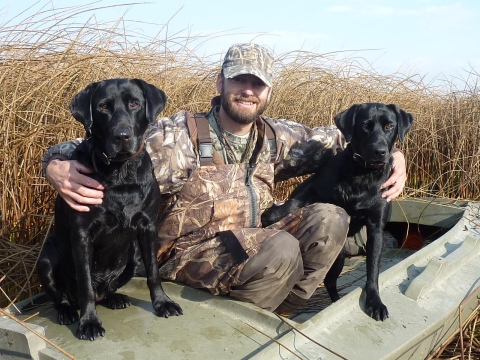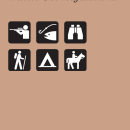
Hunting is allowed on Red Rock Lakes National Wildlife Refuge only during designated times and in designated areas for elk, moose, deer, pronghorn and waterfowl (ducks, geese, coot) only - no other species are allowed to be hunted on the Refuge. Hunting is regulated on the Refuge to promote and maintain healthy wildlife populations. Hunters must be familiar with all hunting regulations.
For management purposes pertaining to hunting, fishing, and protection of wildlife, lands in the Refuge have been separated into closed areas and open areas. Areas closed to hunting total 15,787 acres and some are not open to public entry from 1 October through 15 December. Please see the Hunt, Fish & Public Use Regulations brochure and map later in this section. Areas open to hunting total 38,379 acres and are open to hunting pursuant to regulations and areas designated for specific game species: waterfowl, elk, deer, pronghorn, and moose only. To ensure your safety and enjoyment while visiting Red Rock Lakes National Wildlife Refuge, please take the time to become familiar with regulations. These regulations are designed to protect the sportsman as well as wildlife populations, and to ensure all who hunt on the Refuge have a quality experience. The regulations below govern hunting on National Wildlife Refuges as set forth in Title 50, Code of Federal Regulation. Hunting will be in accordance with all applicable State regulations and in conjunction with Refuge regulations.
Responsible hunting and fishing do not pose a threat to wildlife populations and is necessary for sound wildlife management. Hunting programs can promote understanding and appreciation of natural resources and their management on lands and waters in the National Wildlife Refuge System.
To learn more about hunting opportunities, seasons, and regulations on Red Rock Lakes NWR, please refer to the current Hunting, Fishing & Public Use Regulations brochure later in this section. Only big game (Elk, Deer, Pronghorn Antelope, Moose,) and Waterfowl (ducks, geese, and coot) may be hunted. HUNTING IS CLOSED TO ALL OTHER SPECIES, including, but not limited to: coyote, fox, badger, wolf, bear, mountain lion, rabbit/hare, upland bird, snipe, dove, sandhill crane, and all non-game animals.
BE BEAR AWARE
Grizzly bears are present on all areas of the Refuge to include, but not limited to: forest, willows, sagebrush sagebrush
The western United States’ sagebrush country encompasses over 175 million acres of public and private lands. The sagebrush landscape provides many benefits to our rural economies and communities, and it serves as crucial habitat for a diversity of wildlife, including the iconic greater sage-grouse and over 350 other species.
Learn more about sagebrush -steppe, grasslands, wetlands, lakeshores, and creeks. The carrying of bear spray on your person where it is readily accessible is strongly recommended.
Hunters and boaters should be prepared for rapidly developing storms, winds, and cold temperatures.
The nearest hospitals are in Dillon or Bozeman, MT or Rexburg or Idaho Falls, ID. Towing services are available in Lima or West Yellowstone, MT or Island Park, ID.
Emergencies or violations may be reported to Refuge Headquarters in Lakeview during regular office hours, 8AM-4:00PM, Monday through Friday at 406-276-3536, after hours to officers on patrol or to the Sheriff via 911 or 406-683-3700. Cell phone coverage is poor, but texting may work, particularly on the north side of the valley.
If no answer or after hours when reporting Refuge violations to Refuge Headquarters, please call the National Wildlife Refuge System Violation Reporting Hotline at 1-844-NWR-TIPS (697-8477) or email NWR_TIPs@fws.gov 24 hours a day.
For State hunting and fishing violations you may also contact TipMont at 1-800-TIP-MONT (800-847-6668) 24 hours a day.
For More Information on State Hunting Regulations, contact:
Montana Fish, Wildlife and Parks
For general information, call (406) 444-2535 or TDD (406) 444-1200.
Those seeking nonresident hunting license information should call (406) 444-2950.
For Hearing impaired. State transfer relay service (TRS) TTY/Voice: 711
We appreciate your cooperation and help to maintain a quality hunting atmosphere for all who frequent and enjoy the Refuge.
In addition to Montana State laws, the following Refuge regulations apply to hunting:
A. General Refuge Hunting Regulations.
· Firearms: Persons possessing, transporting, or carrying firearms on National Wildlife Refuge System lands must comply with all provisions of State and local law. Persons may only use (discharge) firearms in accordance with Refuge regulations (50 CFR 27.42 and specific Refuge regulations in 50 CFR Part 32). Title 18, U.S.C., Section 930 prohibits possession of firearms and dangerous weapons inside Federal facilities.
· Firearms may ONLY be fired on the Refuge in conjunction with a legal hunt for which the hunter is licensed.
· Hunting is prohibited in areas closed to hunting as indicated on the Hunting, Fishing, & Public Use Brochure map and/or as otherwise posted.
· No hunting or shooting is allowed within 50 yards of the centerline of any Refuge or county road, camping areas, or parking areas.
· Montana State season and bag limits apply unless otherwise specified.
· Hunting on the Refuge is subject to Federal and State regulations. A Montana hunting license is required.
· The use of paint, flagging, reflectors, tacks, or other man-made material for any purpose is prohibited.
· Trail cameras are not allowed.
· Trapping or baiting is not permitted.
· The use of artificial lights to attract, search for, or spot wildlife is prohibited. *Flashlights/headlamps may be used to search for and retrieve downed game.
· It is illegal to drive or screw any metal objects into a tree or to hunt from a tree in which a metal object has been driven or screwed.
· Removing antlers, bones, horns, or deadheads - shed hunting, is not allowed.
· Outfitted or guided hunting is prohibited.
· Horses may not be used to hunt and are not allowed north of the South Valley Road, except that they may be used to retrieve big game in areas open to hunting.
· Horses may be used for backcountry access to the Centennial Mountains south of the South Valley Road and up Odell Creek Trail for access into mountainous areas beyond the Refuge boundary.
· Horses are not permitted in the campgrounds.
· Only certified weed free hay is permitted on the Refuge.
· Wheeled game carts or other mechanical transportation/retrieval devices are not permitted in wilderness areas. *The bulk of the hunting areas on the Refuge are in wilderness areas - see map.
· Driving off-road or on dirt two-tracks, except that portion of Culver Road when open, is not permitted for any reason, to include retrieving downed game.
· Fires are allowed only in the fire rings provided in the Upper Lake and River Marsh campgrounds. Fires are not allowed in any other areas of the Refuge. The Refuge reserves the right to prohibit all fires in campgrounds pursuant to weather conditions.
· Pack out all trash generated during your hunt/stay, to include spent shotshells. There are no trash removal services at the Refuge.
· All bear attractants, including but not limited to food, garbage, and carcasses, must be stored acceptably in bear-proof storage at night (unless in immediate use) and during the day if unattended.
· Possession or use of alcoholic beverages while hunting is prohibited.
B. Migratory Game Bird Hunting. Hunting of geese, ducks, and coots in a designated area of the Refuge is allowed in accordance with Montana State hunting regulations subject to the following conditions:
· Goose, duck and coot hunting is allowed only in the area surrounding Lower Red Rock Lake. The north boundary is the east-west running fence line 1 mile north of the River Marsh. The west boundary is the west boundary of the Refuge. The south boundary is the South Valley Road and Sparrow Pond Trail. The east boundary is 50 yards east of Odell Creek northward from Sparrow Pond Trail Bridge to the section line separating sections 10 and 11 in Township 14 Range 2 West, then continuing due north to the north boundary. *Hunting is prohibited until 50 yards downstream of the bridge. (Consult Refuge manager prior to hunting to learn specific boundary of the hunting area).
· Lead shot and its possession is prohibited.
· Shotguns shall be plugged to hold no more than three shells.
· Entry into the designated waterfowl hunt area to hunt waterfowl is prohibited prior to two hours before legal shooting time and two hours after legal shooting time only, except that campers in the River Marsh Campground are exempt while inside the fenced campground boundary.
· Elk, deer, and pronghorn antelope are permitted to be hunted in the designated waterfowl hunt area.
· Decoys may not be placed or set the day or days prior to a hunt.
· Temporary blinds for waterfowl hunting may be constructed out of natural material. All blinds must be deconstructed and removed at the end of each day's hunt.
· Hunters must remove all decoys, shell casings, and other personal equipment from the Refuge migratory bird hunting area each day.
· Only non-motorized boats in the hunt area east of the Lower Red Rock Lake dam are allowed. 10 HP motors or less west of the dam are permitted.
· The use of motorized or battery-operated decoys (e.g. MOJOs, motorized spinning wing, & water agitating) is prohibited.
· Electronic duck or goose calls are prohibited.
· Hunters may not enter closed areas to retrieve birds.
· Decoys, boats, or other property left over 48 hours are considered abandoned and will be removed.
C. Big Game Hunting. Hunting of deer, elk, moose, and pronghorn antelope is allowed in designated areas of the Refuge in accordance with Montana State hunting regulations subject to the following conditions:
· Moose hunting on the Refuge portion of Montana moose hunt zone 334 opens October 15 (bulls) & November 15 (cows) and runs through the end of the State moose season.
· Moose hunting is restricted to the willow fen area south of Elk Springs Creek, east of Upper Red Rock Lake, north and west of the South Valley Road, and west of Elk Lake Road at the southeast corner of the Refuge. Moose hunting is prohibited in all other areas of the Refuge.
· Moose hunters with antlerless permits may not harvest a cow moose having a calf/calves trailing her to allow calves an opportunity to survive the winter. Antlerless calves are permitted to be taken with an antlerless moose permit.
· Hunting for elk, white-tailed deer, mule deer, and pronghorn antelope is allowed on the Refuge in designated areas open to those species. Hunting for elk, white-tailed deer, mule deer, and pronghorn antelope is prohibited in the moose only hunting area.
· Hunting stands and blinds must be removed at the end of each day’s hunt.
· Deer, elk, antelope, or moose "drives" – the pushing, steering, ushering, or herding of animals for the taking or attempted taking of any big game is prohibited.
· Horses may not be used to hunt and are not allowed in areas north of the South Valley Road, except that they may be used to retrieve big game in areas open to hunting.
· Hunters may not enter closed areas to retrieve downed game without first contacting Refuge law enforcement or a staff member.


